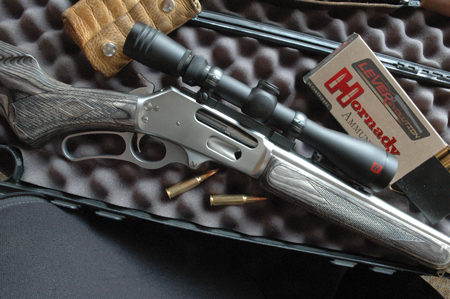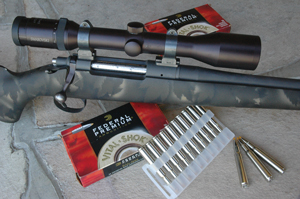
The new Redfield 3-9×40 seems a great match for this Marlin 1895 rifle in .338 Marlin Express.
The name isn’t descriptive. Nightforce has nothing to do with infrared imaging. This optics firm specializes in high-quality rifle-scopes for precision shooting. Since 1993, more world records in long-range Benchrest events have been set with Nightforce scopes than with any other. They’re a top choice among 1,000-yard and 50-caliber marksmen. The 8-32×56 and 12-42×56 Precision Benchrest models have resettable dials with 1/8-minute clicks, as well as glass-etched illuminated reticles. Their four-times magnification range is shared by the NXS series, from the 3.5-15×50 and 3.5-15×56 NSX to the 5.5-22×50 and 5.5-22×56, the 8-32×56 and 12-42×56. Compact scopes for big game hunting recently joined that roster. The 1-4×24 and a 2.5-10×24 sights and, now, a 2.5-10×32 weigh just over a pound with the 30mm bronze alloy tubes common to Nightforce scopes.
 Nightforce specializes in high-power riflescopes. But hunting models have recently appeared. |
Like all but the Precision Benchrest models, the new 2.5-10x has a turret-mounted focus/parallax dial. (The 8-32×56 and 12-42×56 bench scopes wear front-sleeve parallax rings.) A new 3.5-15×50 F1 with first-plane reticle caters to hunters who want the reticle to stay in constant relationship to the target throughout the power range. Nightforce rifle-scopes endure the toughest tests in the industry. Each sight must remain leak- and fog-proof after submersion in 100 feet of water for 24 hours, freezing in a box at a minus 80° F, then heating within an hour to 250° F. Every scope gets pounded in a device that delivers 1,250 Gs, backward and forward. Lens coatings must pass mil-spec abrasion tests.
Nightforce now offers eleven illuminated reticle options. They’re distinctive and appealing because they cover so little of the field. The firm also markets accessories for competitive and tactical shooters. Mil radian windage and elevation knobs deliver .1 mil per click. Long-range shooters can specify a turret with 1-minute elevation and half-minute windage graduations, for big changes in yardage with short dial movement. A “zero-stop” turret has an elevation dial that can be set to return to any of 400 detents in its adjustment range.
One-piece steel scope bases have a recoil lug to ensure the mount doesn’t move. Five heights of steel rings let you install the scope in just the right location. Unimount, machined from 7075-T6 alloy, has titanium crossbolts and a 20-minute taper for long shooting. Nightforce’s Ballistic Program for Windows, and the abbreviated version for Pocket PCs, helps you determine bullet arc at distance. The company assembles its carriage-class optics at its plant in Idaho. (Nightforceoptics.com.)
While Nikon’s optics line has grown this year, the company’s biggest news may be its ballistics program, which you can access free from Nikon’s website. Plug in a cartridge, the bullet type and velocity to get down-range speed and energy data instantly. Specify zero range, and you’ll see the bullet’s arc. Or work backward to find the sight-in range that gives you longest point-blank distance. Nikon has programmed in dozens of popular centerfire rounds. Manipulations are so simple even a cave man can do them. How does Nikon benefit? “We get a chance to show you how our optics help you hit,” explains C.J. Davis. “Beyond that, it’s just good business to do what we can for the industry and for our customers.” Having played a little with the program, I can endorse it. While I’ve no interest in anything that extends my time at a computer screen, Nikon’s ballistics program threatens to do just that!
As for hardware, Nikon riflescopes now include an M-223 series for AR shooters. The 1-4×20, 2-8×32 and 3-12×42 can be used on other rifles, of course; but BDC reticles for the 2-8x and 3-12x M-223 are tailored for popular AR-15 loads. The Monarch line remains Nikon’s flagship, with its “African” and “Long Range” subsets. The 1-4×20 has a 1-inch tube; the 1.1-4×24, available with an illuminated reticle, is a 30mm sight. Both provide four inches of eye relief for fast aim and “recoil space.” They feature German #4 reticles and half-minute click adjustments. The African scopes round out a line tilted to high-power optics by the 2008 debut of an 8-32x50ED SF with 1/8-minute adjustments. The 5-20×44 affords great reach in a sight of reasonable size. For all-around hunting, the 2.5-10×42 is hard to beat.
The 4-16x50SF and 2-8×32, recent additions, pretty much cover the rest of the field. I’ve found Monarch optics to equal the brightest in the industry. The “Gold” and “X” series have 30mm tubes. “Coyote Special” rifle-scopes introduced last year (a 3-9×40 and a 4.5-14×40) still sell well. They feature BDC reticles and camouflage finish. A reflection-fighting screen hides the front lens. The Omega 1.65-5×36 scope for muzzleloaders is also a hit, as is the 1.65-5×36 SlugHunter. Both have a generous five inches of eye relief and BDC reticles suited to the trajectories of the most common bullets. Omega’s parallax setting is 100 yards, that of the SlugHunter 75.
The value-oriented ProStaff stable has a new entry for 2010: this 4-12×40 is an excellent scope that gives you bright images, a useful power range and a svelte tube that complements trim rifles. Nikon also lists two new range-finders this year, one for archers, the other for riflemen. There are new 42mm models in the mid-priced Monarch ATB binocular line. Nikon’s top-end EDG binoculars (7×42, 8×42, 10×42, 8×32, 10×32) with open-bridge design and a locking diopter are good glasses made better with ED lenses. Ditto the EDG Fieldscope, 85mm or 65mm. Its zoom eyepieces (16-48x and 20-60x) interchange with Nikon fixed-power eyepieces. (Nikonhunting.com.)
In 2010, Pentax is taking on the recession with a new series of value-priced rifle-scopes it calls the GameSeeker II line. There are six models, from the yeoman 3-9×40 to a 4-16×50 and a light-grabbing 2.5-10×56. They feature one-piece, 1-inch alloy tubes, fully multi-coated optics and finger-adjustable windage and elevation dials. Choose from a standard plex reticle or the Precision Plex BDC. GameSeeker scopes are priced from around $100, which should make them popular.
 Oldie but goodie: This Swarovski Habicht variable complements an Ultra Light rifle in .30-06. |
Last year, Pentax added a 3-15×50 GameSeeker to that stable. Five-times magnification offers more versatility than you’ll likely need for big game. I chose instead a 3-9×32 for a moose hunt. That 12-ounce sight was perfect for my Ruger carbine in .300 RCM. Its high level of resolution helped me shoot a bull when I picked out a sliver of antler deep in shadowed timber. You can choose from eight 1-inch variable GameSeekers, plus 4×32 and 6×42 fixed-power sights. The 30mm Lightseeker 30 series comprises 3-10×40, 4-16×50, 6-24×50 and 8.5-32×50 scopes. Pioneer II models, 3-9×40 and 4.5-14×42, feature 1-inch tubes, fully multi-coated optics. Among Pentax spotting scopes, the compact PF-63 Zoom with fixed 20-50x eyepiece is particularly well suited to hunting, while the PF-80ED and PF-100ED excel when weight doesn’t matter. Interchangeable eyepieces include 32x, 46x and 20-60x options for the 37-ounce PF-65ED, which also accepts a Pentax PF-CA35 camera adapter for 35mm SLRs.
Pentax binoculars include a7x50 Marine model with built-in compass on a liquid bearing for fast dampening. Waterproof, with twist-up eye-cups and a click-stop diopter ring, the rubber-armored 7×50 has all the best features of the Pentax roof-prism DCF roof prism binoculars. These come in 8x, 10x and 12.5x, with 32mm to 50mm objectives, with phase-corrected prisms in alloy and polycarbonate shells. A Porro prism PCF line includes 8×40, 10×50, 12×50 and 20×60 binoculars. Among my favorite hunting glasses is an unlikely choice: the Pentax 9×28 BCF LV. Despite its modest exit pupil, this binocular gives me bright images, and at 13 ounces it’s eminently portable. I like the twist-out eyecups, click-stop diopter. The surface is easy to grip. Other good choices for the trail: 8×36 and 10×36 DCF NV roof-prism glasses. (Pentaxsportoptics.com.)
Long revered for excellence in riflescopes, Schmidt & Bender has hewed mainly to the European traditions of big tubes and first-plane reticles. Last year S&B announced its first 1-inch riflescope for the American market. The 16-ounce 2.5-10×40 Summit has a rear-plane reticle. Optically, it seems to me the equivalent of higher-priced Classic and top-end Zenith lines. It has the right power range and profile for at least 99 percent of all big game hunting!
Recent changes in S&B administration have not shifted its main focus. A small company by most standards, S&B still caters to people who want the very best in optical sights. Its roots lie in the hunting field, but it has brought innovation to the tactical table too. Three years ago a S&B 3-12x was adopted by the U.S. Marine Corps for its 30- and 50-caliber sniper rifles. Its 34mm Police/Marksman scopes rank among the most sophisticated LE sights around. Lighted mil dot reticles, as on S&B’s 4-16×42 P/M II, come with 11-setting turret-mounted rheostats.
The automatic shutoff saves battery while the previous setting automatically engages when you hit the illumination switch again. A side-mounted parallax adjustment hides the battery cage. Windows on windage and elevation knobs show you where the reticle is in its adjustment range. Flash-dot reticles incorporate a beam-splitter to illuminate a dead-center dot, which vanishes at a touch if you desire just the black reticle. The Police/Marksman line now comprises 17 scopes with 30mm and 34mm tubes. The latest is a 5-25×56 PM II with locking turrets.
For hunting, I’ve come to favor S&B’s 3-12×42 Classic, a versatile, durable, good-looking 30mm scope that delivers brilliant, tack-sharp images. I like the 6×42 and 10×42 fixed-power Classics as well, available with 1-inch and 30mm chassis. The Zenith series comprises four 30mm variables: 1.1-4×24, 1.5-6×42 (a great hunting sight!), 2.5-10×56, 3-12×50. They wear the P/M’s “Posicon” windage and elevation dials. (Schmidt-bender.de or scopes@cyberportal.net [the website of its U.S. importer].)
This article is an excerpt from Gun Digest 2011. Click here to get your full copy!
Recommended AR-15 resources for gun owners:
 New! The Gun Digest Book of the AR-15 Vol. III
New! The Gun Digest Book of the AR-15 Vol. III
The Gun Digest Book of the AR-15 Vol. I
The Gun Digest Book of the AR-15 Vol. II
Gunsmithing the AR-15, How to Maintain, Repair & Accessorize
Find more gun books, DVDs and downloads at gundigeststore.com.








